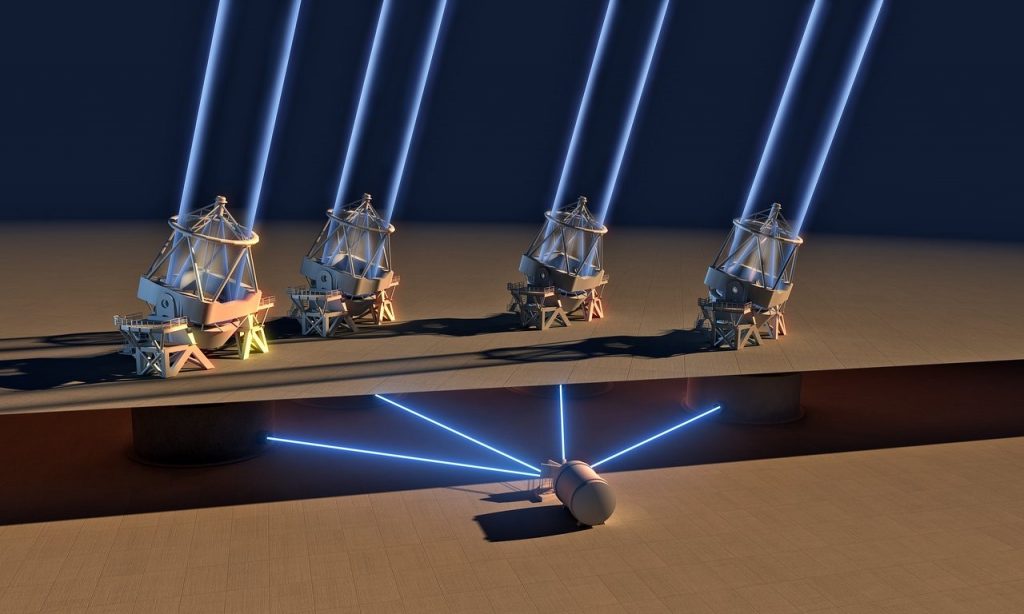
The VLT
I arrived in Antofagasta with the intention of booking a visit at the VLT, the Very Large Telescope, one of the biggest astronomical centers in the world, known to be the world’s most advanced visible-light astronomical observatory. I knew it was necessary to book at least three weeks in advance. I immediately called the astronomical center and booked for a Saturday (guided visits are only organized on weekends): the first group, the first visit of the day, meet at the entrance of the astronomical complex at 9:00 am. I would feel one of the most intense emotions of my life after about 15 days from that moment. And so it was. For the occasion I had to rent a car, a mandatory aspect for any visitor considering the absence of public transport to get to the destination.
Departure from Antofagasta at 6:30 to be able to arrive well in advance. A very exciting car trip for an Astronomy enthusiast like me. Moving away from the city to go deeper and deeper into the desert area to the south, anybody soon realizes the extremely dry, barren and mountainous context that distinguishes the area chosen for the construction of the VLT, as well as for any other astronomical center in the country. An average relative humidity between 5 and 10%, more than 300 nights of clear skies a year, the extraordinary absence of rainfall (on Cerro Paranal it never rained in living memory) and the altitude (2635m ) make this place one of the best sites in the world for astronomical research, if not the best ever. An extraordinary combination of natural factors, to which I’d also add the distance from light sources (the most intense is the city of Antofagasta, more than 130 km away) and the effect of Humboldt current (I advice the reading of the article “The Humboldt Current, the Hadley cell and the Föhn effect – The perfect combination”).

Heading the VLT, region of Antofagasta
The view from the entrance to the astronomical facility is unique. The altitude of Cerro Paranal, the mountain on whose summit the VLT was built, allows you to admire the surrounding mountainous desert area. The 4 large telescopes of the VLT are already visible even if, to reach them, it is necessary to drive for another couple of minutes. The emotion grows. The engineering area is right there, on the right, very close to the first entrance to the astronomical center. Climbing up the road we approach the summit of Cerro Paranal until… here they appear! Four huge main telescopes (Unit Telescopes: UTs), with a 8,2 meters primary mirror and a 1,12 meters secondary mirror, flanked by 4 smaller auxiliary telescopes (Auxiliary Telescopes: ATs) with a 1,8 meters primary mirror.
Antu, “the Sun”, Kueyen, “the Moon”, Melipal, “the Southern Cross” and Yepun, “Venus”, are the names in Mapuche language chosen by ESO (European Southern Observatory), the European organization for astronomical research in the southern hemisphere, for these giants of science on the occasion of the inauguration of the observatory in the afternoon of March 5, 1999, after 8 long years of work to prepare the Cerro Paranal for the ESO building project and to complete the installation of the great astronomical facility. With an ultra-high resolution image of the spiral galaxy NGC 2997, Antu was the first of the 4 UTs, all them Ritchey-Chrétien wide-field reflector telescopes with altazimuth mount, to provide evidence of the extraordinary potential of the new plant and therefore the first of the large telescopes to be used.

Once we got to the summit of Cerro Paranal, a volunteer guide showed up and the two-hour visit begins. The route, with an initial presentation video (the same in every other ESO observatory), offers a visit at two of the 4 UTs, passing through the operational area and the Residencia, a hotel that was built on a grond depression and where astronomers, who work at night, rest in the daytime.
One of the most pleasant sensations was the impression that the place, more than any other astronomical facility I have been able to visit, represented my passion “completed”, the “salvation” for Astronomy, the perfect place to guarantee a great future for astronomical research, feeling close to stars like never before even without seeing them. In addition, the possibility of applying as a volunteer guide for the weekend public visits (after a short training course) thrills any Astronomy enthusiast even more.

View near Yepun telescope, with 3 of the 4 ATs
But what is the real secret of the VLT? What aspect makes the famous plant so important and unique in the world?
The VLT, which is operational since May 1999 (Antu telescope), is today the most advanced optical instrument in the world and the most important ground-based astronomical research facility. But where does its uniqueness lie? Does it have anything to do with its size? No, the size of the primary mirror of UTs, even if surprising and fundamental in optical terms, is not the real secret of the VLT. A simple search on the Internet is enough to find out that in the world there are optical telescopes with much wider mirrors. The LBT (Large Binocular Telescope) of the Mount Graham International Observatory, with a primary mirror with a diameter of 8.4 meters (USA, Italy, Germany), the GTC (Gran Telescopio Canarias) of the Roque de los Muchachos (Spain), with a primary mirror with a diameter of 10.4 meters or the telescopes of the Keck Observatory (USA), both with a primary mirror with a diameter of 10 meters, are just some examples.
The real secret of the VLT lies in two of its three possible operating modes.
The first consists in the individual use of each single UT to obtain images of sky objects four million times fainter than those perceived with the naked eye during a clear night under the stars. The second method consists in using the VLT as a single non-coherent instrument, combining the light collected by all the large telescopes which, in quantitative terms, translates into the same amount of light collected by a 16 meter single telescope. Thanks to the application of the third generation spectrograph ESPRESSO, which was inaugurated in November 2017, this last operating mode based on the incoherent combination of light, which is a combination resulting from a simple sum of the light collected by each single UT, has made the VLT the largest optical telescope in the world today operating in terms of light-gathering surface.

The image shows in a simplified way how the light collected by the four telescopes of the VLT is combined in the Espresso instrument, which is located below the platform of the astronomical facility.
This milestone will be exceeded in a few years by the ELT, the Extremely Large Telescope, which is now under construction at Cerro Armazones, and whose first light, that is the event in which an astronomical instrument is used for the first time, is scheduled for 2024.
Before clarifying the third operating mode of the VLT, it is necessary to shed light in simple words on two fundamental aspects of the vast world of Astronomy.
Why does curiosity push man to build larger telescopes? What does interferometry consist of and how did it come about?
In a nutshell, the larger the primary mirror of a telescope, the more details will be achieved since greater will be the amount of light collected by the instrument. In terms of amount of light, a telescope with a primary mirror twice the diameter of another one will be able to collect an amount of light four times greater. It is precisely for this reason that, taking up the second operating mode of the VLT, the sum of the sizes of the 4 UTs primary mirrors corresponds in terms of yield to a 16 meter single telescope, and not to a 32 meter telescope. In the astronomical field, however, the construction of larger mirrors larger involves considerable expenses and it is therefore very expensive even to increase by a few meters the diameter of an optical ground-based telescope. Just think of the construction costs of the VLT project, which cost about 500 million dollars, or those for the construction of the future ELT (Extremely Large Telescope) estimated at over one billion euros.
To overcome the problem of high construction costs, astronomers have therefore developed a new technology to be able to achieve the same resolution and details results: interferometry. This observation technique combines the light gathered from two or more telescopes making them act as a single unit with a primary mirror of a diameter equivalent to the distance between the telescopes.
And it is precisely on interferometry where the principles of the third operating mode of the VLT lie.
The third modus operandi of the VLT, known as the interferometric mode, consists precisely in a recombination of the light collected simultaneously by the 4 ATs or, much more rarely, by the 4 UTs with the purpose of significantly improving the image resolution.
I am referring to the famous VLTI, the Very Large Telescope Interferometer.
Entirely focused on speckle imaging techniques, which is a set of observational techniques based on technologies whose sole purpose is to improve the resolution of astronomical images obtained with ground-based telescopes, the VLTI exploits almost exclusively the observational action of ATs, which were conceived and made precisely with the aim of interferometry and, therefore, excellent substitutes for UTs which in most cases are used individually.
Remotely controlled by the VLTI operations center, the ATs, unlike the UTs, are mobile telescopes, and can therefore be moved freely on rails with the possibility of being placed in 30 different positions along the platform of the astronomical center.
This freedom of positioning makes it possible to increase the distance between the auxiliary telescopes, known as interferometric baseline, up to the greatest possible distance, equal to 202 meters compared to the 130 meters of the UTs. With such an interferometric baseline, the resolution and details achieved by interferometry correspond to those that would be obtained with a 100 meter single telescope.
Therefore, the use of auxiliary telescopes allows to obtain the highest interferometric imaging result.

Through a complex system of reflecting mirrors placed along underground tunnels, the light beams coming from the 4 telescopes are conveyed to the same common focal point and directed towards the combination instruments of the VLTI: PIONIER and GRAVITY for a recombination in the near infrared and MATISSE in the medium infrared. During the path towards the combination instruments, the trajectory of the light beam is maintained with an accuracy of 1/1000 of a millimeter for over 100 meters.
Results? Details 25 times greater than those perceived by a single UT or, in more technical terms, details that, in order to be obtained in the absence of interferometric mode, would require a telescope with an aperture equal to the width of the area delimited by the telescopes involved.

The VLT Survey Telescope (VST), which was the latest telescope to be installed at the Paranal Observatory, is one of the largest telescopes in the world designed to scan the skies in visible light, providing updated and detailed sky maps. The rapid and detailed acquisition of wide-angle images of large areas of the celestial vault allows the detection and the preventive characterization of the objects of interest which can be subsequently deepened by the UTs of the VLT.
Active and adaptive optics
Among the most important technological innovations of recent years in the astronomical field, those of active and adaptive optics, applied to most large-sized ground-based optical telescopes, cannot be overlooked.
The first technique, applied since the early 1980s, was developed as a response to the need to overcome the problem of deformation of primary mirrors with a diameter greater than 3 meters, made with a progressively reduced thickness to reduce their weight and, therefore, to support the construction of large astronomical plants. As in the case of the VLT, the rotation of large telescopes inevitably causes an oscillation of the large primary mirror which results in its deformation. The solution to this natural distortion, which is inversely proportional to the thickness of the mirror, was recognized in the application of “small pistons” called actuators that are placed at its base and positioned on an extremely rigid cell and that, once activated, automatically adjust the shape and the position of the mirror during the whole observing activity. Through constant monitoring of a reference star and computerized analysis, this technique allows to adjust the smallest distortion phenomenon, ensuring the maximum image quality. Obviously, this technique was applied for our VLT: the primary mirror of each UT lie on 150 actuators.
Despite the great results achieved, active optics, however, fails to solve the problem of atmospheric turbulence.

And this is where adaptive optics comes into play, one of the most modern techniques in the astronomical field.
The effect of atmospheric turbulence, known in the world of astronomy and astrophotography by the term “seeing”, affects astronomical observation anywhere on the planet, including at Cerro Paranal, reducing the resolution, which is the ability to distinguish details.
The humidity and the combination of atmospheric gases cause a distortion of the light beams coming from any astronomical object. The result with the naked eye translates into the classic stellar twinkling that, in the presence of good seeing and therefore good conditions of atmospheric turbulence, is sometimes impossible to notice, giving us the rare opportunity to admire perfectly point-like stars. At very high levels, however, things change, especially if the goal is to achieve surprising results. This phenomenon can be solved by observing directly from space, as in the case of the Hubble Space Telescope and the James Webb Telescope, which is next to launch.
But what about observing from the ground?
Adaptive optics technology started being developed since the early 1990s. This technique is based on a device, which is called wavefront sensor, that observes a star and analyzes its distortion to understand how to deform a telescope mirror in order to restore the image of the star itself and, consequently, of all objects in its surroundings. The fact that turbulence changes rapidly requires extremely sensitive wavefront sensors capable of sampling the distortion in thousands of points, and electronics capable of giving indications to the deformable mirror in a fraction of a thousandth of a second. Furthermore, if the astronomical object to be studied does not have a sufficiently bright star nearby, the Very Large Telescope can create an artificial one by firing a laser beam in the direction of the object.
The adaptive optics technique therefore allows to obtain images with the same resolution as those obtained from space … if not higher.


Recently mounted on the “spider” structure on top of the VLT’s UT4 (Yepun), the new deformable secondary mirror is the largest adaptive mirror ever built and is the heart of the new adaptive optics system that will allow the telescope to produce images even sharper.

Imagine of Neptune with and without adaptive optic.






0 Comments